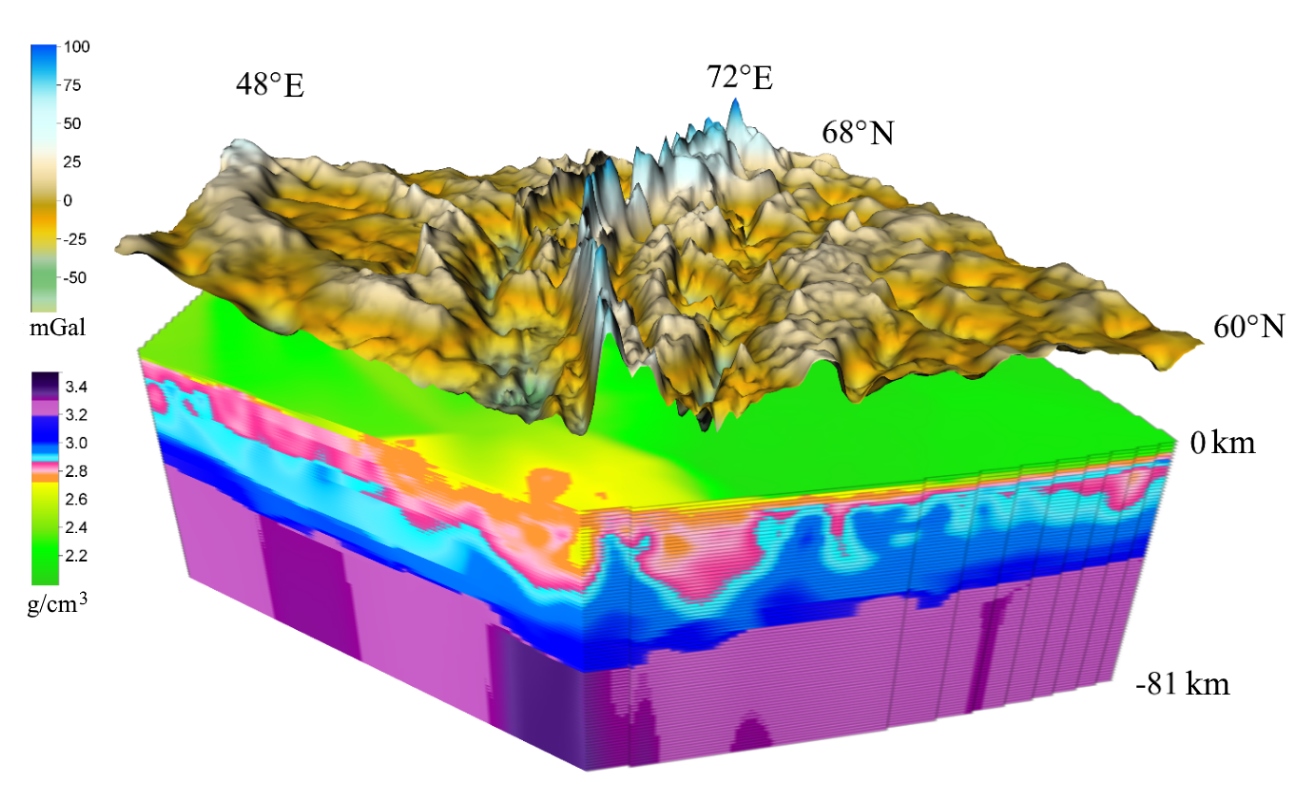GRAFEN v0.2 - GRAvity Field Ellipsoidal density model Numerical computations for CUDA-enabled distributed systems
 A performance-effective program for gravity field* calculation for layered ellipsoidal density model. The program can calculate gravity filed in arbitrary points outside the density model. Input density model discretization is assumed to be regular in Gauss-Kruger (aka Transverse Mercator) projection (thus, irregular in geodetic coordinates).
A performance-effective program for gravity field* calculation for layered ellipsoidal density model. The program can calculate gravity filed in arbitrary points outside the density model. Input density model discretization is assumed to be regular in Gauss-Kruger (aka Transverse Mercator) projection (thus, irregular in geodetic coordinates).
The program is intended to work on distributed systems with CUDA accelerators.
*normal derivative of gravity potential
Update 2020-12-30: GRAFEN - TOPO - calculate gravity field for topography
Update 2020-09-04: Linux + AMD ROCm support
You will need these only if you want to build the program yourself. If you just want to run the binaries, see How to run the example section below.
- Visual Studio 2017+ (Community version will do, select "Release" Configuration before building)
- CUDA 10.1
- MS MPI
- GeographicLib 1.49
- Boost 1.71.0
The program primarily designed to work with Surfer (© Golden Software) Grid File Format
- Ubuntu 20.04 (or anything that can run ROCm)
- mpich (or any other MPI implementation)
- ROCm 3.7+, see the installation guide
- GeographicLib 1.49
- Boost 1.71.0
Specify paths to GeographicLib, Boost and MPI in src/rocm.makefile and run cd src && make to build. You can use example/timan.sh to run the example (it is required to dowload and unpack resmodel_timan/ from Releases)
-
GPU
- Nvidia GPU with CUDA compute capability 3.5 or higher (any modern 2015+ Nvidia GPU will do)
OR
- AMD GPU with ROCm support
-
At least 2GB GPU memory to run the example
Specify file for the output field:
-dat2D dat2DfiledExample.dat - XYV file, where V is the gravity filed value (in milligals). XY - arbitrary points in Gauss-Kruger projection (km). V is ignored as input. See example example/timan.dat
or
-dat3D dat3DfiledExample.dat - XYZV file, where V is the gravity filed value. XY - arbitrary points in Gauss-Kruger projection (km). Z and V are ignored as input. Z will be set to H (see bellow).
or
-grd7 grdField.grd - Surfer grd7 file. Grid dimensions are used as file input. All coordinates in Gauss-Kruger projection (km). Old grid values are ignored and will be rewritten.
Specify input parameters:
-Hf 0.00001 - Height over the Ellipsoid on which the field is being calculated (km). This parameter is ignored if -dat3D was specified. It is not recommended to pass exactly 0.
-dens dens_model - Directory with layered density model (set of grd7 files)
-Hfrom -81 - Depth of the lower grid layer (density model)
-Hto 0 - Depth of the upper grid layer (density model)
-Hn 81 - Number of layers of the density model (must be same as amount of files in dens_model)
-l0 57 - Central meridian for Gauss-Kruger projection
-DPR 180 -(optional) Radius of point-field replacement (in km). If you don't specify this option, replacement radius will be automatically deduced, based on condition that the output field accuracy won't be reduced more than by 0.1%.
-toRel - (optional) Convert input density model to relative values
-noInvFileOrder - (optional) Don't invert the file order of density model
-transposeSolver - (optional) Solve gravity problem with transposed forward gravity field operator. Files in dens_model will be rewritten, "output field" is now treated as input.
- Install MS MPI
- Go to
exapmle/. - Put
cudart64_101.dll,grafen_cu101.exeand uncompressed folder with modelresmodel_timan/here (all files are in Releases). - Fix
hosts.txt. You need to put here hosts that will execute the program. First host is 'root' host - it does not do actual computations. All other hosts perform computations using one GPU per host. You can utilize several GPUs on a single host by putting the same host entry several times in the file. For example, if you have 2 GPUs on host 192.168.5.1 and 4 GPUs on host 192.168.5.2. Yourhost.txtshould be as follows:
192.168.5.1
192.168.5.1
192.168.5.1
192.168.5.2
192.168.5.2
192.168.5.2
192.168.5.2
Note, that the first host has one extra entry compared to the amount of its GPUs.
If you have one GPU on the same machine you're running the program on, you can leave default hosts.txt without changes.
- Fix path to
mpiexecinmpirun.cmdif needed. ChangeC:\inC:\%cd:~3%to your network drive (e.g.\\MYHOST\SHARED_FOLDER\) or, if you're running the program locally, change it to your drive letter. - Run
timan.bat. After the program is done you will have calculated field intiman.dat.
- Make sure you have NFS between the nodes (the files of the program and the data should be available via the same path).
- Make sure you have
smpdrunning on all hosts under the same user. - Make sure your firewall doesn't interfere with MPI connections.
If you're using our program in your work, please, reference this repo and one of our papers:
resmodel_timan in Releases is a real solution of gravity filed inversion problem for a part of Timan-Pechora platform (Russia). The methodology of acquiring such a result is described in the next paper (please reference it if you're going to use the model in your work):
This software is distributed under MIT License. © Alexander Chernoskutov, Denis Byzov
The files of resmodel_timan are distributed under MIT License. © Bulashevich Institute of Geophysics, Ural Branch of the Russian Academy of Sciences, Yekaterinburg, Russia
Development of this software was supported by the Russian Foundation for Basic Research (project no. 17-05-00916_a).